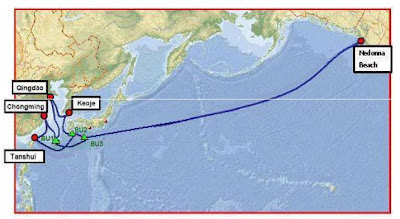Some updates (see the other older post) :
- "Originally announced as a 5.12 terabit system in December 2006, the cable system has increased in capacity, and when fully deployed when phase two is completed, TPE will be a 6 terabit submarine cable system" (Submarine Cable News); 6.4 Tbps I guess
- Suppliers: Tyco (prime); ASN; NEC
- "With the addition of NTT Communications, the TPE cable system will add a submarine cable link to Japan giving the TPE cable system six landing sites"
- "The operating capacity of the system is 3.2 Tbps, an increase of 25 percent over the original system design. With a minimum 80 wavelengths per fiber, TPE has the highest wave-density of any submarine cable in the world at this length."
Verizon“We are excited that the first phase of the Trans-Pacific Express is complete and ready for our customers’ use,” said Kaveh Hushyar, senior vice president of network planning and engineering for AT&T. “AT&T today carries more than 15.8 petabytes of IP and data traffic on an average business day, and this traffic volume is growing at more than 50 percent year over year. Our participation in the TPE network helps to ensure that we’re continually staying several steps ahead of our customers’ ever-growing global communications needs.”
AT&T owns or leases capacity on more than 80 submarine cable systems, which span more than 478,000 fiber-route miles (approx. 760,000 km) around the globe, including several submarine cable routes that the company uses to carry traffic between the Asia-Pacific region and North America.
Verizon Business multinational customers with IP, data and voice communications traffic moving onto this cable system, which is now active, will see immediate benefits including additional capacity, greater physical diversity, reduced latency, improved performance and seven-way mesh network diversity, the company said in a statement.
In addition to the physical diversity of the TPE submarine cable route, customers also will take advantage of a network architecture design called meshing, which provides alternate paths for rerouting traffic in the event of a cable cut or network disruption. When a service interruption occurs and meshing is needed, the equipment housed in network buildings on land allows the rerouting of voice and data traffic within 50 to 100 milliseconds. (Finally, a commercial submarine mesh restoration, Cool!)
As a leader in global mesh networks, Verizon Business is the first to offer seven-way trans-oceanic mesh diversity across both the Pacific and Atlantic oceans. The company’s mesh network in northern Asia includes physical node diversity in major cities, coupled with backhaul and cable system diversity to provide superior survivability during network issues. Mesh nodes were recently installed in Hong Kong, South Korea and Taiwan. Japan was already included in the Pacific global mesh network.
“When you combine the complete TPE package we are offering our Verizon Business multinational customers, it’s second to none in the industry”


No comments:
Post a Comment